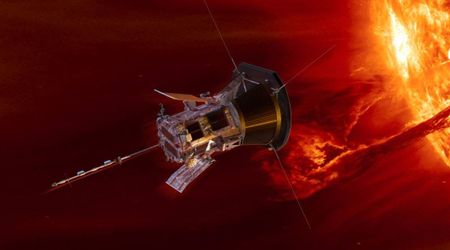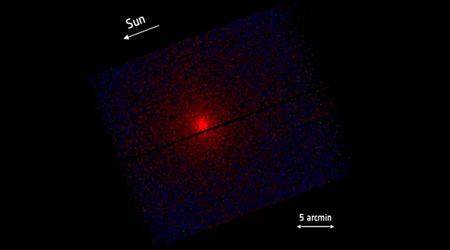What are some of the biggest objects in the universe?

Earth may seem big to us at about 24,901 miles (40,075 kilometers) around the equator, but it’s unfathomably tiny when compared to other celestial objects and the universe itself.
Even our Sun, which could fit more than a million Earths inside of it, is not a big star, average on the whole, but puny compared to hypergiant stars and there are certainly bigger objects than stars.
What are the largest objects in the universe? Let’s dive in.
Defining a single object can be difficult. The Antarctic blue whale is the biggest animal on Earth, but contains bones, organs, and trillions of cells. Similarly, many astronomical objects are built up of smaller objects, including objects that we may consider important, like planets, which, like cells, are minuscule on the scale of the universe.
Large is also a difficult concept: volume and mass don’t necessarily correlate in space. Some of the “biggest” things in our universe are incredibly dense meaning they weigh many, many times more than you would expect from their “size” such as their circumference or volume.
Light-years: the typical measurement used for distance in the universe. It correlates to how far light travels in a year. To get a rough sense, it takes light 8 minutes to reach Earth, so we are 8 light-minutes from the Sun. It takes about 5 and a half hours for sunlight to reach Pluto at about 3.6 billion miles (5.8 billion km) away. The closest star to our own, Proxima Centauri is 4.25 lightyears away from us. The observable universe is over 46 billion light-years in any direction from Earth and therefore about 93 billion light-years in diameter.
In general, the order of the universe is as follows, starting with our star systems as the smallest element:
- Star systems (like our solar system) contain at least one star and a number of smaller objects like planets, dwarf planets, moons, asteroids, and comets.
- Galaxies are made up of millions to billions of star systems, typically powered by a supermassive black hole
- Galactic Clusters are small groups of galaxies that are held together by gravity
- Galactic Superclusters are large clusters of galaxies held together by gravity
- Walls/ Filaments: Massive superclusters of galaxies
- The universe is made up of everything above as well as numerous other smaller bodies such as quasars which are powered by black holes

The Largest Discovered Objects in the Universe in Ascending Order
14. The Saraswati Supercluster
Previously the largest supercluster of galaxies containing 43 massive galaxies clusters stretching 652 million light-years (even bigger than the Laniakea Supercluster which contains our Milky Way galaxy and is 520 million light-years across)
13. The CfA2 Great Wall (a.k.a. The Coma Wall)
A massive galactic filament stretching 500-750 million light-years across discovered in 1989.
12. The Pisces-Cetus Supercluster Complex
it was the first galaxy filament to be discovered (in 1987) and spans 1 billion light-years long, containing 60 clusters. It contains:
- The Pisces-Cetus Supercluster
- The Perseus-Pegasus chain
- The Pegasus-Pisces chain
- The Sculptor region with the Sculptor Supercluster and the Hercules Supercluster
- The Laniakea Supercluster (which contains the Virgo Local Supercluster in which we reside and the Hydra-Centaurus Supercluster)
11. The Perseus-Pegasus Filament
a galaxy filament containing the Perseus-Pisces Supercluster 1 billion light-years across. It is adjacent to the Pisces-Cetus Supercluster Complex and was discovered in 1985 although it is likely that Clyde W. Tombaugh identified it and reported it as the Great Perseus-Andromdea stratum of Extra-Galactic Nebulae in 1936 during his search for trans-Neptunian planets that eventually found Pluto.
10. The BOSS Great Wall
a structure consisting of 4 superclusters of galaxies. Its mass and volume exceed the Sloan Great Wall, but it is smaller at only 1 billion light-years across. It was found in early 2016 with the Baryon Oscillation Spectroscopic Survey (BOSS) of the Sloan Digital Sky Survey (SDSS).
9. The King Ghidorah Supercluster
supercluster of at least 15 clusters of galaxies and interconnected filaments, making it the most massive galactic supercluster discovered at 1.3 billion light-years across. It was discovered just last year in 2022.
8. The South Pole Wall
the largest contiguous feature in local volume located about the celestial South Pole at 1.37 billion light-years across. It is often compared to the Sloan Great Wall, but is smaller. Its discovery was announced in 2020 as this region of the sky had not previously been completely surveyed and it was hidden by galactic dust and clouds, only revealed through its gravitational influence.

7. The Sloan Great Wall
large cosmic structure of galaxies 1.38 billion light-years across discovered in October 2003 based on data from SDSS which also later found the BOSS Wall mentioned previously. It is between 1.8-2.7 times longer than the CfA2 Great Wall, continuing several galactic superclusters.
Since its discovery, it has been suggested that it is actually an alignment of three structures as opposed to one single structure, but this has not been confirmed.
6. The Clowes-Campusano LQG
large grouping of 34 quasars (extremely luminous active galactic centers powered by black holes) 2 billion light-years across. It lies in extremely close proximit to the Huge-LQG (upcoming), which has puzzled scientists since they share similar features and could actually be a single structure, connected by a currently hidden filament, but this has not been confirmed. It was the largest known structure in the universe for 20 years.
5. U1.11 LQG
Large Quasar Group of 38 quasars 2.5 billion light-years across in the constellations of Leo and Virgo. It was discovered in 2011 during the SDSS and was the largest known structure in the universe until the Huge-LQG was discovered the next year. It is located very close by the Clowes-Campusano LQG.
4. “The Giant Arc”
large galactic structure about 3.3 billion light-years across discovered in June 2021. It was discovered from data in the SDSS. If it was visible in the night sky, it would form an arc spanning up to 20 full moons.
3. The Huge-LQG
largest-known large quasar group at 4 billion light-years across and with an estimated 73 quasars and a mass of 6.1 quintillion Suns. Its discovery was announced in January 2013 after 2 months of verification. Since its discovery, there has been some dispute regarding its identification methods which has not been resolved as of yet.
2. The Giant GRB Ring
a ring of 9 gamma-ray bursts (GRBs) that are currently considered to be associated with the largest known cosmic structures and are usually spread out meaning they are likely the same structure. Discovered in 2015, it is one of the largest known structures in the universe at 5.6 billion lightyears across.
1. The Hercules-Corona Borealis Great Wall
discovered in 2013, it is the current best candidate for the biggest single structure in the universe. It is the biggest supercluster of galaxies, about 10 billion light-years across. It is important to note that even scientists debate about if the Hercules-Corona Borealis Great Wall should be considered a single structure or not and that many think it is too big to exist as such.
Honorable Mentions
UY Scuti
Often considered the biggest star, it could fit more than 1.700 of our Suns inside of it. If UY Scuti was at the center of our solar system, it would extend past the orbit of Jupiter. (Some measurements of this star put it lower than these numbers, but there are other gigantic stars of similar sizes and they are the biggest discovered so far.)

TON 618
largest black hole: this black hole powers a quasar with an estimated mass of 66 billion Sun and a shadow light-weeks long.
The Fermi Bubbles
massive structures/ blobs 25,000 light-years tall coming out from the Milky Way, invisible except in certain wavelengths of light. These are believed to be leftover energy from when our galaxy’s central black hole went through a particularly ravenous period of attracting nearby objects.
The Tarantula Nebula
often considered the largest and most active star-forming region, stretching up to over 1.800 light-years at its longest section.
Protocluster SPT2349-56
In the early formation of the universe, 14 galaxies crashed into each other and formed the most massive known gravitationally bound object in the universe. Squeezed into only about 300,000 lightyears, it will eventually coalesce into a single galaxy.
IC 1101
the biggest known galaxy, spanning 4-5.5 million light-years across compared to our Milky Way galaxy at 100,000 light-years across, making it 50 times larger and about 2,000 times more massive than our galaxy. Galaxies contain stars and star systems of planets and smaller astronomical objects, but are considered a single object or structure.
The Supervoid in Eridanus
technically, not an object, but rather a region of space with no observed objects. Spanning 1.8 billion light-years, this huge region of empty space is oddly devoid of stars, gas, dust, and even dark matter.
Conclusion
Size is all relative based on what you are comparing. The Earth is often the biggest thing we can hope to understand on a true level and even that is difficult to truly grasp. Yet, the Earth is small, even in our own solar system.
The observable universe is massive at 93 billion light-years in diameter, but we hope you have enjoyed this breakdown of some of the biggest astronomical objects in it.









